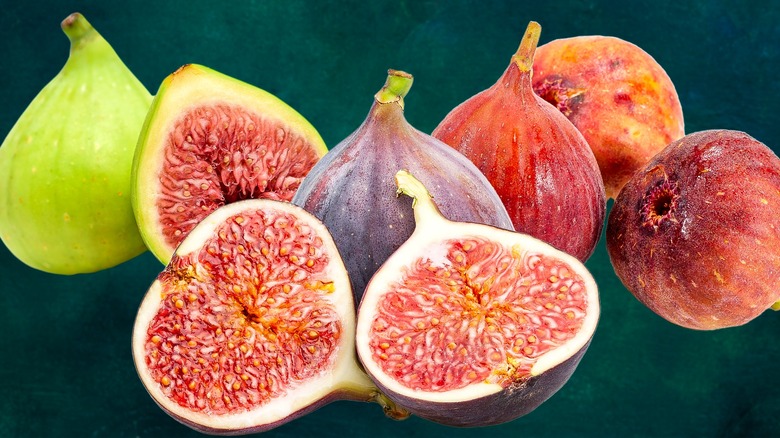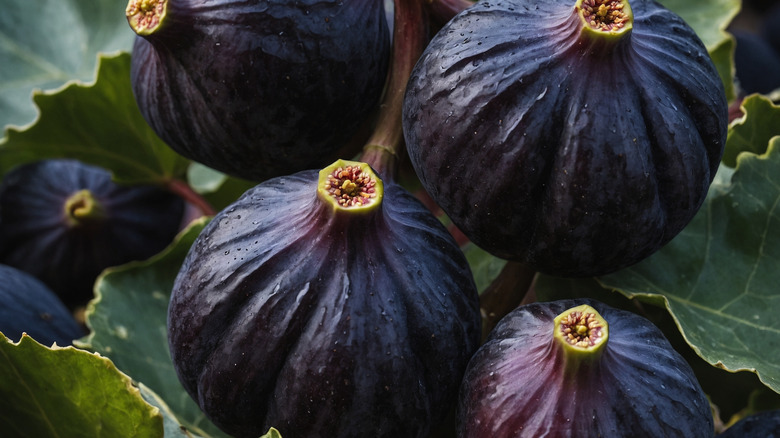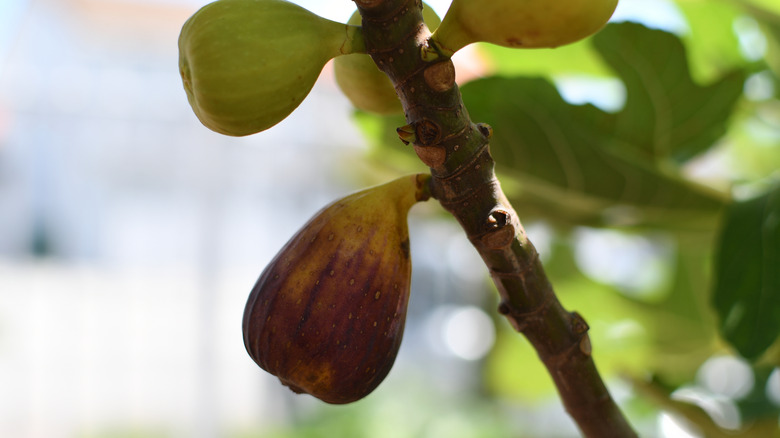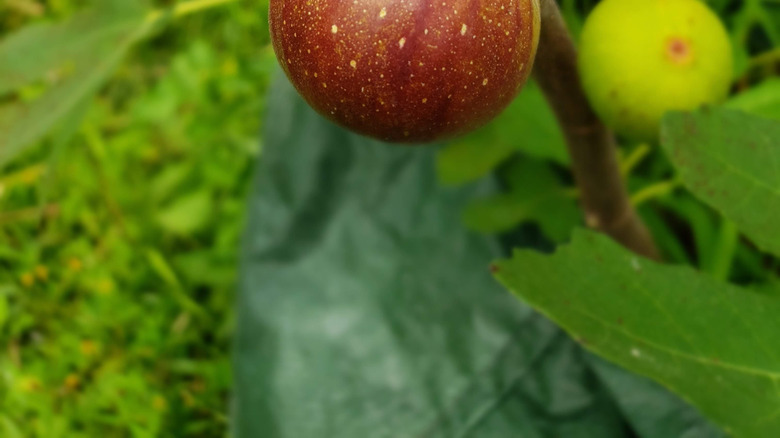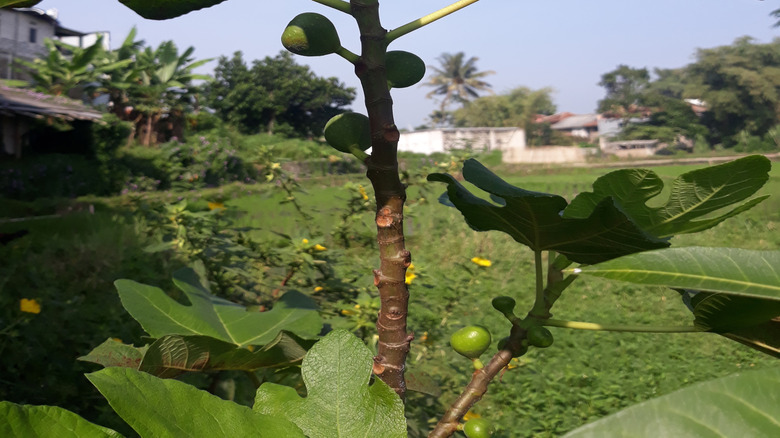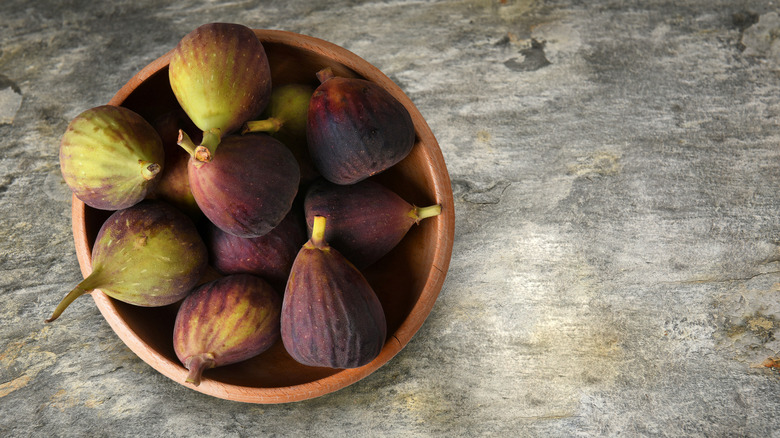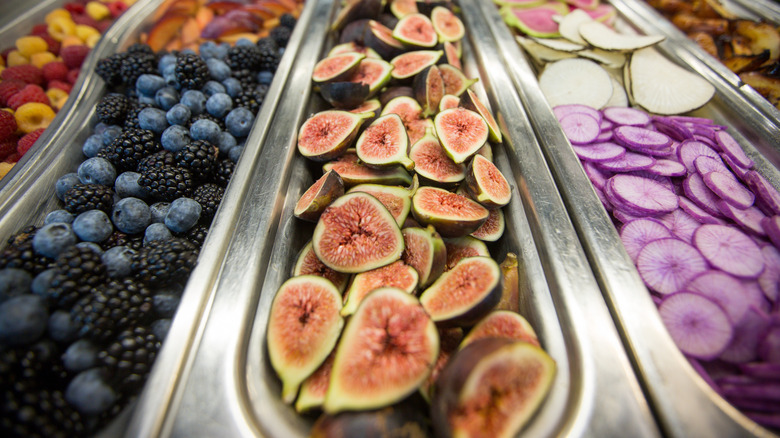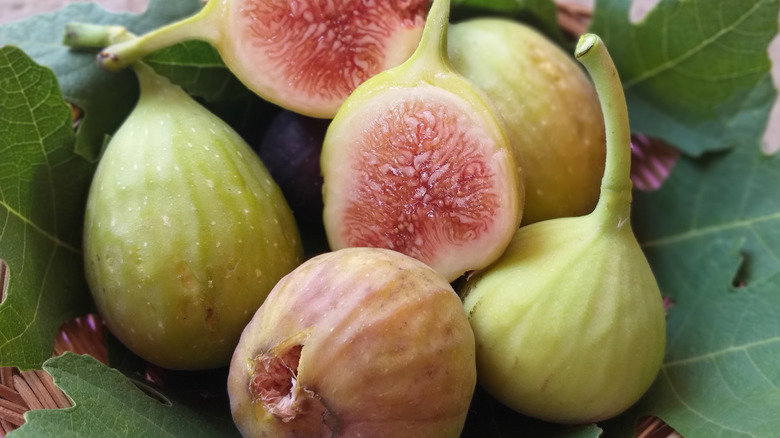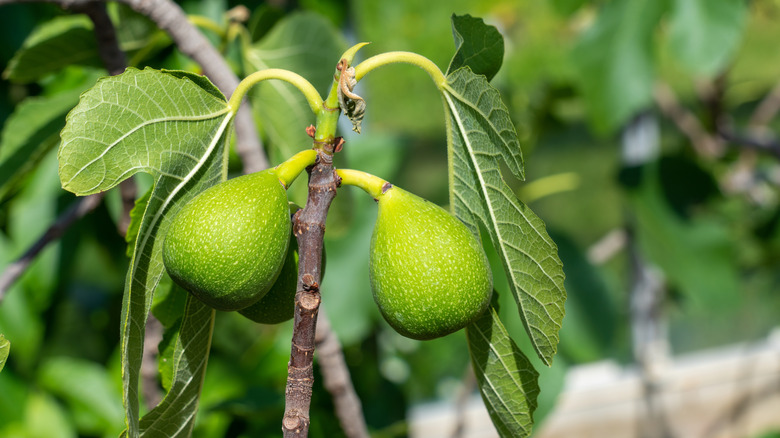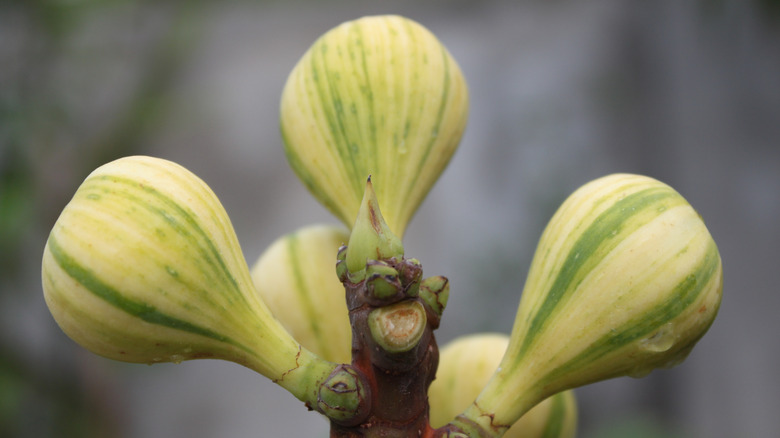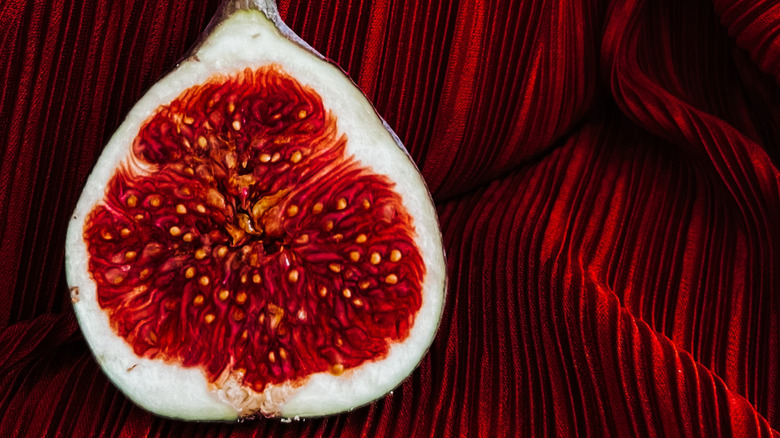10 Types Of Figs And How To Best Use Each
Figs, the ancient fruit that's as mysterious as it is delicious. Whether you've seen them on cheese plates or hidden inside fancy pastries, figs have an almost mythical reputation in the culinary world. But here's the secret — figs aren't just a one-note ingredient. With dozens of varieties out there, figs come in a spectrum of flavors, colors, and textures that can transform your dishes from good to absolutely irresistible. From their deep, jammy sweetness to subtle, honey-like undertones, figs are your recipe wingman waiting to take center stage.
As someone who has worked closely with figs in and out of the professional kitchen throughout my career — whether developing recipes or experimenting with varieties from different regions — I've come to appreciate just how versatile this ancient fruit truly is. Figs aren't just a sweet snack; they're a dynamic ingredient with unique flavors, textures, and culinary applications. From cultivating my own figs at home to crafting dishes that let their complexity shine, I've learned that each variety has its perfect use. And that's what this guide is all about.
Figs' range is why they're so popular across professional kitchens. We're talking salads, roasts, pastries, snacks — you name it, there's a fig for it. The real question is, how do you choose from so many types? That's where this guide comes in. I'm about to walk you through 10 fig varieties and the best ways to use them to elevate your meals, bring sophistication to your desserts, and even sneak a little sweetness into your everyday snacks.
Black Mission figs
Black Mission figs are the rock stars of the fig world, and it's not hard to see why. Celebrated for their deep purple-black skin and rich, jam-like interior. These figs have an intense sweetness that's reminiscent of molasses, with a subtle earthiness that makes them ideal for both sweet and savory dishes. Their most remarkable use, however, is when they're roasted with a drizzle of honey and paired with sharp elements like cured meat. The heat from roasting caramelizes the natural sugars, creating a dish that balances the sweet depth of the figs with the salty richness of prosciutto — a surefire way to impress at any dinner party.
While Black Mission figs are versatile, their real magic happens when used in savory appetizers. Roasting them brings out their best qualities, transforming their texture into something even more indulgent. The concentrated richness of these figs pairs well with blue cheese, so don't hesitate to combine them with strong, contrasting flavors. The combination of caramelized figs, creamy cheese, and savory meats is where this variety truly shines.
If you're craving something sweet, Black Mission figs' jammy flesh also works beautifully in desserts, but the best use for these figs remains in elegant, savory dishes. The contrast they offer, especially when roasted, elevates any appetizer to new heights.
Brown Turkey figs
Brown Turkey figs may not have the overwhelming sweetness of other varieties, but their mellow, honey-like flavor makes them incredibly versatile. With a brownish-purple skin and amber flesh, these figs offer a subtle sweetness that works best when paired with bold, savory flavors. The best way to showcase Brown Turkey figs is by wrapping them in prosciutto and drizzling them with a touch of olive oil. This combination allows the figs to complement the salty richness of the prosciutto without being overshadowed, creating a balanced appetizer that's both simple and sophisticated.
While they're excellent in both sweet and savory dishes, Brown Turkey figs are particularly suited for savory plates. Their gentle sweetness provides just the right amount of contrast without overwhelming the other ingredients. You can also slice them into salads or serve them with tangy cheeses like blue or goat cheese, where their mild flavor enhances the overall dish. But their finest moment comes when they're paired with salty, savory elements that allow their sweetness to subtly shine.
Though they're a great candidate for preserves and jams, Brown Turkey figs reach their peak when they're part of a savory dish. Their mild sweetness and soft texture make them a natural fit for appetizers that focus on complementary flavors.
Kadota figs
Kadota figs are a refreshing departure from the typical sweetness of other fig varieties, making them a favorite for those who appreciate a more subtle fruit. With their light greenish-yellow skin and firm, almost custard-like flesh, Kadotas bring a gentle, earthy flavor that's perfect for dishes requiring a milder touch. Their best use is on the grill, where the heat caramelizes their natural sugars, turning them into a golden, sweet but not overpowering accompaniment to savory dishes like grilled meats or seafood.
When grilled, Kadota figs take on a rich, smoky flavor that enhances their delicate sweetness without making the dish feel overly fruity. Adding fresh herbs like thyme or rosemary during grilling can further elevate the earthy notes of the figs, making them an ideal choice for a savory side dish that feels refined yet uncomplicated. The subtle sweetness of the Kadota fig pairs beautifully with herbs and citrus, offering a sophisticated balance of flavors.
Though they can be used in desserts or eaten fresh, Kadotas shine brightest when grilled. Their firm texture holds up well under heat, and the caramelization process brings out a richness that's unexpected for a fig that starts off so mild. For those seeking a more understated fruit to complement savory dishes, Kadota figs are the perfect choice.
Adriatic figs
The unique Adriatic figs are often referred to as "candy-stripe figs" for good reason. Their pale green skin hides a vibrant, neon-pink interior bursting with sweetness. These figs are exceptionally sugary, with a flavor profile that includes hints of honey and berries. While Adriatic figs can be used in a variety of dishes, their best use is simple: Enjoy them fresh, perhaps with a drizzle of balsamic glaze or paired with creamy yogurt. Their natural sweetness is so intense that minimal preparation allows their unique flavor to truly shine.
When eaten fresh, Adriatic figs are a perfect snack or dessert, with a taste that's almost indulgent in its simplicity. Their striking color and candy-like flavor also make them a stunning addition to fruit platters or salads. For something a bit more elaborate, they can be layered on tarts or used to complement salty cheeses like ricotta or burrata. However, the real magic of Adriatic figs lies in their natural sweetness, which doesn't need much enhancement.
While they pair well with both sweet and savory ingredients, Adriatic figs are best showcased when kept simple. Their intense sugar content and striking appearance make them the ideal fig to serve as a fresh, eye-catching treat that delivers on flavor.
Calimyrna figs
Calimyrna figs, a variety cultivated in California, share their origins with Smyrna figs from Turkey, and both have golden skin and a rich, nutty flavor. Their best use is in dried form, where their naturally chewy texture and caramel-like sweetness make them a perfect snack or ingredient in trail mixes and baked goods. Fresh Calimyrna figs, however, offer a buttery flavor that's ideal for pairing with tangy elements like goat cheese, making them a delicious addition to salads or cheese boards.
While many figs are prized for their jammy sweetness, Calimyrnas stand out for their balanced nuttiness, especially when dried. The drying process intensifies the fig's flavor, making them excellent in breads, cakes, or granola bars. When fresh, these figs have a delicate flavor that's perfect for more refined pairings, particularly when combined with rich, savory ingredients. Their firm flesh holds up well to cooking, making them a great addition to both sweet and savory dishes, but they truly shine when served as part of an appetizer or snack.
Calimyrna figs are versatile, but their nutty sweetness and chewy texture when dried make them especially suited for recipes that benefit from added depth and chewiness. Whether fresh or dried, their unique flavor profile offers something different from the typical fig sweetness, giving them a standout role in any kitchen.
Sierra figs
Sierra figs, with their light green skin and juicy, amber-colored flesh, bring a mild sweetness that leans towards honey without overpowering other flavors. This balance makes Sierra figs versatile, but their best use is in fresh salads, where they can harmonize with peppery greens and creamy cheeses like feta or goat cheese. A simple drizzle of balsamic vinaigrette can elevate the combination, creating a dish that balances sweet, savory, and tangy elements in a refreshing way.
Sierra figs are ideal for those who prefer a subtle sweetness in their fruit. Their delicate flavor allows them to complement rather than dominate, making them perfect for dishes where a gentle sweetness is key. They're also a natural choice for pairing with nuts and grains in heartier salads, adding a touch of juicy sweetness to balance richer flavors and textures.
For preserving, Sierra figs are excellent for jams and jellies. When cooked, their sugars break down into a luscious, spreadable consistency that's ideal for slathering on toast or stirring into yogurt. However, their best expression remains in fresh, vibrant salads, where their subtle flavor can meld beautifully with a variety of ingredients.
Alma figs
Alma figs may be small, but their flavor is anything but. With light brown skin and honeyed, floral flesh, these figs bring a rich sweetness that shines in baked goods. The best use for Alma figs is in treats like cookies, cakes, and breakfast bars, where their soft, tender texture blends seamlessly into doughs and batters, adding natural sweetness without overwhelming other flavors.
When baked, Alma figs develop a warm, mellow richness that pairs beautifully with spices like cinnamon and nutmeg, making them an ideal ingredient for spiced desserts and breakfast treats. You might fold them into oatmeal or scone batter for a unique twist on morning classics, or mix them into granola for a chewy, honeyed addition. Their small size and soft flesh make them a delightful surprise in each bite, with a sweetness that complements rather than overshadows.
Though they're lovely in savory salads or grain bowls, Alma figs truly excel in baked applications. Their floral notes and honeyed taste bring depth to sweets, making them a must-try for any dessert lover looking to add a touch of natural fruit sweetness to their recipes.
Excel figs
Excel figs, with their smooth, golden-yellow skin and rich, honey-like interior, offer a luxurious flavor that's both sweet and versatile. Their best use is fresh in breakfast dishes or salads, where their balanced sweetness can shine without overpowering. Slicing them over yogurt or oatmeal creates an easy, naturally sweet breakfast while adding them to salads brings a soft texture and subtle sweetness that pairs beautifully with ingredients like arugula, walnuts, and feta.
When enjoyed fresh, Excel figs reveal a gentle honeyed flavor that complements both savory and sweet elements. Their flesh is soft yet holds up well in salads, making them a great choice for dishes that thrive on contrasting textures. They also add depth when paired with nuts or creamy cheeses, rounding out salads or light meals with a mild, caramel-like sweetness.
For those who enjoy baking, Excel figs are wonderful in muffins or scones, where the gentle heat intensifies their natural sugars. But their true strength lies in fresh applications, where their honeyed sweetness can balance richer flavors without overpowering. If you're looking for a fig that brings a touch of understated luxury to any dish, Excel figs are the perfect choice.
Panachée (Tiger Stripe) figs
Panachée figs, also known as Tiger Stripe figs, are as striking in appearance as they are in taste. With vibrant green and yellow stripes on the outside and bold pink flesh inside, these figs offer a sweet, berry-like flavor that's both complex and refreshing. Considered by many to be extremely delicious, Panachée figs are best enjoyed fresh, where their unique sweetness and visual appeal can take center stage.
These figs make an eye-catching addition to fruit platters or salads, where their bold colors and flavor stand out. They're particularly well-suited to pair with mild, creamy cheeses like burrata or mozzarella, creating an appetizer that balances sweet and savory with ease. Panachée figs can also be tossed into a fresh fruit salad, adding both visual interest and a touch of sweetness that enhances the other fruits.
For those feeling creative, Panachée figs also caramelize beautifully when grilled, bringing out an even richer flavor. Whether used fresh or grilled, their balanced sweetness and berry-like flavor make them an unforgettable addition to any dish. With their visual charm and delicious taste, Panachée figs are a true showstopper in the fig family.
Violette de Bordeaux figs
Violette de Bordeaux figs are often considered royalty among figs, with their deep, dark purple skin and incredibly sweet, jammy flesh. Known for a complex flavor profile that combines notes of red wine and berries, these figs are a true indulgence and best enjoyed fresh. Sliced and served with soft cheeses like goat cheese or Brie, Violette de Bordeaux figs make a luxurious appetizer that highlights their rich, fruity flavor.
Their intense sweetness makes them ideal for simple, elegant desserts where they can truly shine. A fig reduction made from Violette de Bordeaux figs, for instance, can be drizzled over meats like duck or lamb for a refined, sweet-savory contrast that brings out the figs' deep flavors. If you're a dessert lover, try incorporating them into baked goods like tarts or galettes, where their concentrated sweetness pairs beautifully with buttery crusts and spiced fillings.
While they're versatile, Violette de Bordeaux figs are best showcased in fresh applications or as a simple reduction sauce. Their small size belies the intensity of flavor they pack, making them a standout choice for dishes that call for something special. For fig lovers seeking depth and sophistication, Violette de Bordeaux figs are simply unmatched.
